Push and Pull
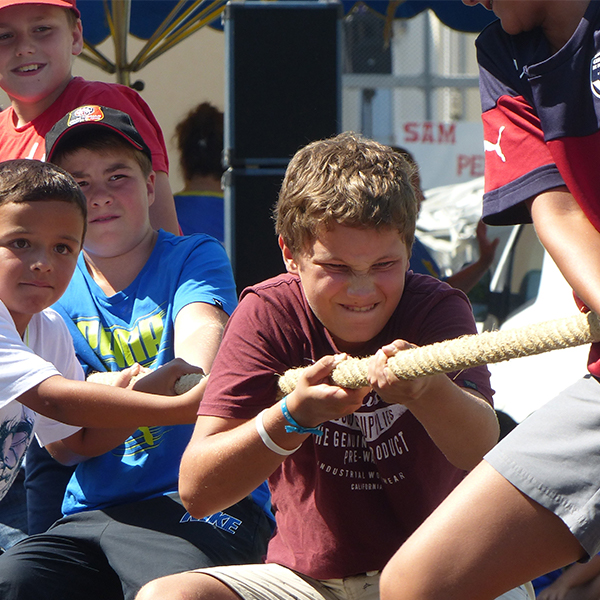
Tug-of-War game (Stéphane Chadourne, Pixabay)

Tug-of-War game (Stéphane Chadourne, Pixabay)
How does this align with my curriculum?
| Grade | Course | Topic |
|---|
Students develop and apply Observing, Comparing & Contrasting and Sorting & Classifying skills as they explore the forces of push and pull acting on everyday objects.
Overview
This inquiry provides opportunities for students to observe, classify and compare the forces involved in familiar activities such as pushing a swing, propelling a skateboard forward, or pulling a wagon.
Timing
30-45 minutes
Setting the Stage
A force can be considered a push or a pull upon an object. It can cause an object to speed up, slow down, change the direction of movement, remain in place or change shape. The most straightforward forces to understand are those in which physical contact is made with an object, such as pulling a sled or pushing against a door. Through exploration and identification of the forces of push and pull that can be applied to simple objects, this inquiry provides opportunities for students to observe, classify and compare the forces involved in familiar everyday activities such as pushing a swing, propelling a skateboard forward, or pulling a wagon and the forces of push and pull.
This inquiry could begin from:
- experiences at the school or community playground. Discuss using questions such as:
- “What did you do to make the swing move?”
- “How does a teeter-totter move and change direction?”
- “If someone wanted to swing higher, what would have to change about how the swing is made to move?”
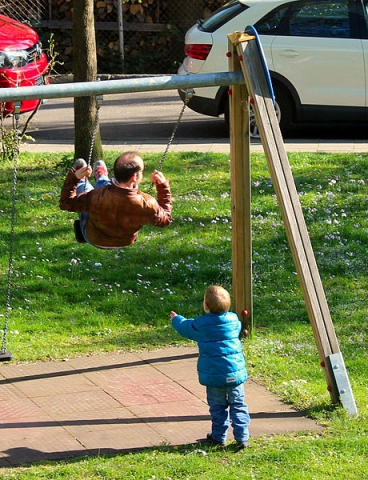
- viewing a variety of images of opposite actions (e.g., up/down, open/close,walk/run, lift/drop, push/pull, smile/frown). Discuss using questions such as:
- “I notice that you paired the pictures. How did you decide which pictures went together?”
- “What are some other opposite actions that we could add to this collection?” (e.g., bend/straighten, attack/defend, move backward/move forward.)
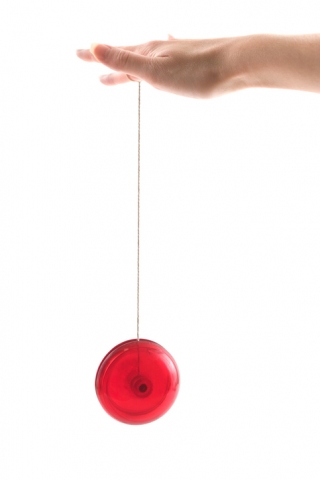
- reading a book such as Motion: Push and Pull, Fast and Slow by Darlene Stille. Discuss using questions such as:
- “What ways can things move?”
- “What is an example of a pushing force? A pulling force?”
- “What words might we use to describe motion?”
- “What types of motions and forces are fun to experience?”
- “What types of motions and forces might be scary or dangerous to experience?”
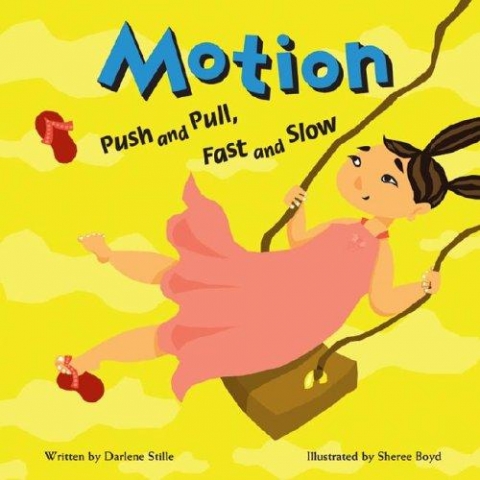
Details
- Ping-pong ball – 1 per group
- Straws – 3-4 per group (ensure 1 per student)
- String – 1 piece per group, approximately 45 cm long
- Craft stick – 1 per group
- Plastic spoon – 1 per group
- Plastic cup – 1 per group
- Ruler – 1 per group, 15 cm (6 inch)
- Plastic zip top bag – 1 per group
- Chart paper
- Hoops for Venn diagram
- Science journal

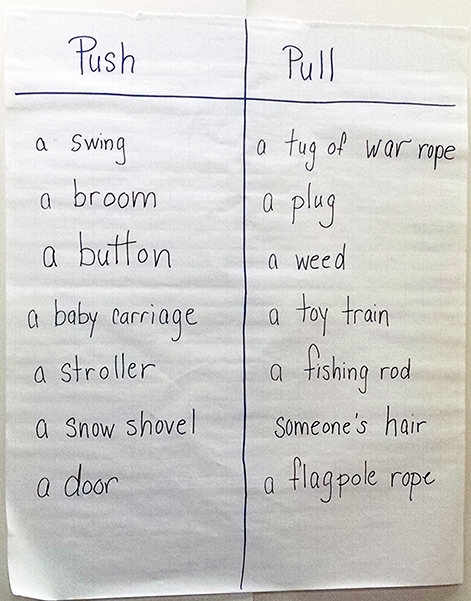
- Source and fill plastic bags with the following materials – 1 ping-pong ball, 1 straw per student, 1 piece of string, 1 craft stick, 1 plastic spoon, 1 plastic cup and 1 ruler. Create enough bags to provide one set of materials to each group of 3-4 students in your class. Note: For hygiene purposes, ensure that there is 1 straw for each student and discard the used straws after the inquiry.
- Review the Sorting Mats Learning Strategy and share samples (e.g. ,T-Chart, Venn diagram) with students as possible ways to compare and record ideas about where they encounter pushes and pulls.
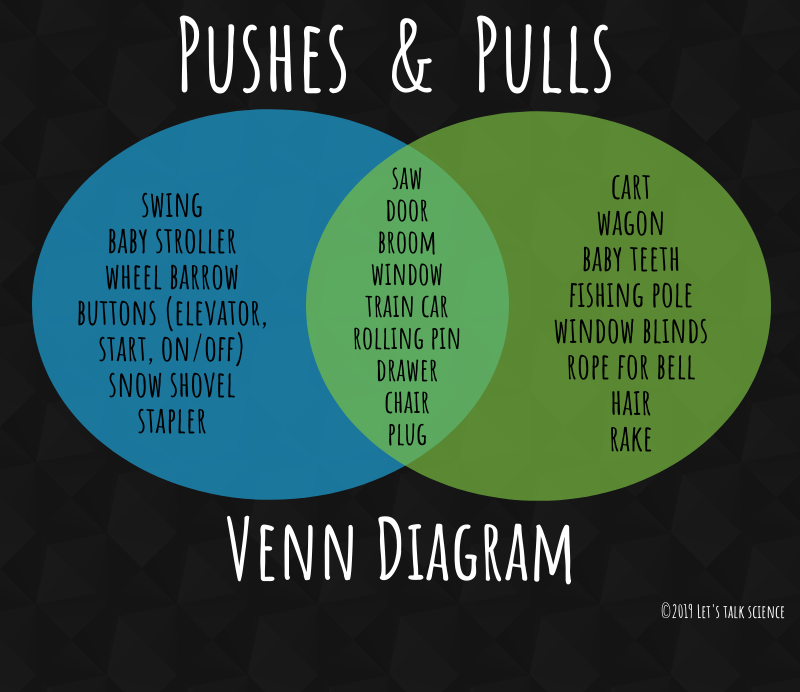
Students use the Sorting Mats learning strategy to develop and apply the skills of Observing, Comparing & Contrasting and Sorting & Classifying as they explore the forces of push and pull acting on everyday objects.
Students:
- use the bag of suggested materials to explore and observe all the ways they can move the ping pong ball back and forth across a table. Small groups of students seated across from each other at a desk or table are best.
- compare and contrast observations about what happens, what is the same, and what is different between different types of pulls and pushes, etc. (e.g., students should conclude that a ping-pong ball on a table can be made to change direction if a different type of force is applied - i.e., a push or a pull – and that the strength of the push or pull can make the ball go faster, change direction, or fall off the table).
- sort and classify the information gathered about the different ways that the ping-pong ball can be pushed and pulled using sorting mats or hoops, and record (in words, drawings or photos) the results of their sorting and classifying using a T-chart or a Venn diagram.
- Educator supports (as necessary) with guiding questions about how to use a Venn diagram or T-chart.
- communicate understanding of pushes and pulls as forces that can move objects in many different ways.
Observe and document, using anecdotal comments, photos and/or video recordings, student’s ability to:
- Observe - students make use of their senses to observe examples of forces of push and pull on the ping pong ball.
- Compare & Contrast - students compare and contrast the different ways that the ball can be pushed and pulled.
- Sort & Classify - students sort and classify things/actions that either exert a push and/or a pull, or that need a push and/or a pull to work.
- Record - students record examples of the forces of push and pull they observe.
- Communicate - students share their understanding in a variety of ways using specialized vocabulary (e.g., force, push, pull, direction, opposite).
| Students: Saying, Doing, Representing |
Educator Interactions: Responding, Challenging |
|---|---|
| Students observe examples of the forces of push and pull on the ping-pong ball. |
|
| Students compare and contrast the forces of pull and push they observe. |
|
| Students sort and classify the forces they observe as either pulls or pushes. |
|
| Students record and communicate their understanding of forces and how the strength of a push or pull affects how an object moves. |
|
Literacy
- Ask questions (e.g., to learn more about other forces such as friction and buoyancy)
- Communicate learning in a variety of ways (e.g., using T-charts and Venn diagrams)
- Use appropriate vocabulary (e.g., “We could push the car in a forward direction from behind. A tow truck could also pull the car forward from the front of the car. So I think both a push and a pull force can cause forward movement.”)
Mathematical Thinking
- Compare the relative strength of different forces (e.g., “That stronger push was able to send the ping pong ball flying off the table.”)
- Read primary data presented in graphs, charts, etc., and describe the data using comparative language (e.g., “There are three more examples of push than pull on the chart”)
- Represent (e.g., using pictures, diagrams, graphs, tables, numbers, words, and/or symbols)
Physical Education
- Developing manipulation skills by exerting a force on objects or experiencing force from objects when sending, receiving, or retaining objects (e.g., throwing, catching, trapping, collecting, kicking, punting, dribbling, carrying, volleying, striking)
- Developing effort awareness (e.g., thinking about how our body moves and exploring the forces we can create with our bodies)
If your students are interested in learning more, the following may provoke their curiosity:
- Extend the exploration of pulls and pushes to other areas inside and outside of the classroom or at home, observing and recording examples of things that exert a push and/or a pull, or that need a push and/or a pull to work.
- Explore the push and pull of magnets. Conduct an inquiry such as Magnificent Magnets where students can explore magnets as a non-contact force that causes movement.
- Friction is another direct contact force that students can easily understand and explore. Friction is a force that slows or resists motion. Provide opportunities for students to continue exploring motion by conducting an inquiry such as How Surfaces Affect Motion.
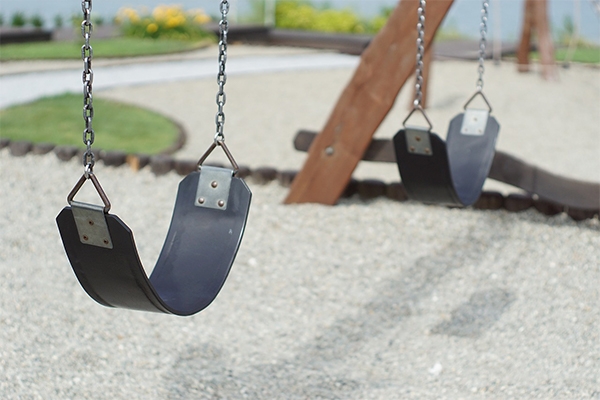
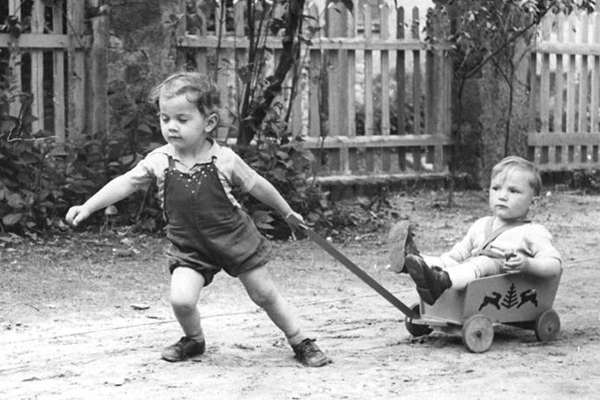
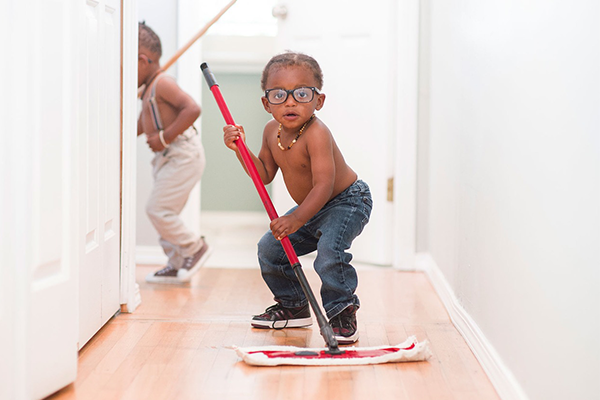
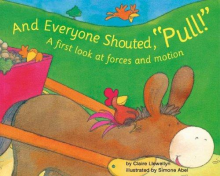
And Everyone Shouted "Pull": A First Look at Forces and Motion
by Claire Llewellyn
Learn about forces and motion as you join the farm animals on their trip to the market. The wheels on their cart help when they push, pull and stop on their journey.
ISBN: 9781404806566
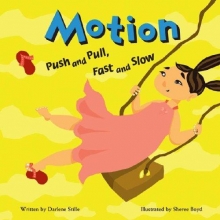
Motion: Push and Pull, Fast and Slow
by Darlene R. Stille
These books answer kids’ questions about the world around them—and encourage them to ask more.
ISBN: 1404802509
How Surfaces Affect Motion (Lessons)
Will it slide or stick? Students conduct a fair test to investigate how different solid surfaces affect the movement of an object on a ramp.
Design & Build a Non-Slip Boot Tread (Lessons)
Design and build a boot tread that will use friction to prevent slipping on an incline.
Design & Build a Toy that Moves (Lessons)
Students will work collaboratively to design and build a toy that is moved using forces applied by magnets.
Materials
- Ping-pong ball – 1 per group
- Straws – 3-4 per group (ensure 1 per student)
- String – 1 piece per group, approximately 45 cm long
- Craft stick – 1 per group
- Plastic spoon – 1 per group
- Plastic cup – 1 per group
- Ruler – 1 per group, 15 cm (6 inch)
- Plastic zip top bag – 1 per group
- Chart paper
- Hoops for Venn diagram
- Science journal


Preparation
- Source and fill plastic bags with the following materials – 1 ping-pong ball, 1 straw per student, 1 piece of string, 1 craft stick, 1 plastic spoon, 1 plastic cup and 1 ruler. Create enough bags to provide one set of materials to each group of 3-4 students in your class. Note: For hygiene purposes, ensure that there is 1 straw for each student and discard the used straws after the inquiry.
- Review the Sorting Mats Learning Strategy and share samples (e.g. ,T-Chart, Venn diagram) with students as possible ways to compare and record ideas about where they encounter pushes and pulls.

What to Do
Students use the Sorting Mats learning strategy to develop and apply the skills of Observing, Comparing & Contrasting and Sorting & Classifying as they explore the forces of push and pull acting on everyday objects.
Students:
- use the bag of suggested materials to explore and observe all the ways they can move the ping pong ball back and forth across a table. Small groups of students seated across from each other at a desk or table are best.
- compare and contrast observations about what happens, what is the same, and what is different between different types of pulls and pushes, etc. (e.g., students should conclude that a ping-pong ball on a table can be made to change direction if a different type of force is applied - i.e., a push or a pull – and that the strength of the push or pull can make the ball go faster, change direction, or fall off the table).
- sort and classify the information gathered about the different ways that the ping-pong ball can be pushed and pulled using sorting mats or hoops, and record (in words, drawings or photos) the results of their sorting and classifying using a T-chart or a Venn diagram.
- Educator supports (as necessary) with guiding questions about how to use a Venn diagram or T-chart.
- communicate understanding of pushes and pulls as forces that can move objects in many different ways.
Assessment
Observe and document, using anecdotal comments, photos and/or video recordings, student’s ability to:
- Observe - students make use of their senses to observe examples of forces of push and pull on the ping pong ball.
- Compare & Contrast - students compare and contrast the different ways that the ball can be pushed and pulled.
- Sort & Classify - students sort and classify things/actions that either exert a push and/or a pull, or that need a push and/or a pull to work.
- Record - students record examples of the forces of push and pull they observe.
- Communicate - students share their understanding in a variety of ways using specialized vocabulary (e.g., force, push, pull, direction, opposite).
Co-constructed Learning
| Students: Saying, Doing, Representing |
Educator Interactions: Responding, Challenging |
|---|---|
| Students observe examples of the forces of push and pull on the ping-pong ball. |
|
| Students compare and contrast the forces of pull and push they observe. |
|
| Students sort and classify the forces they observe as either pulls or pushes. |
|
| Students record and communicate their understanding of forces and how the strength of a push or pull affects how an object moves. |
|
Cross-curricular Connections
Literacy
- Ask questions (e.g., to learn more about other forces such as friction and buoyancy)
- Communicate learning in a variety of ways (e.g., using T-charts and Venn diagrams)
- Use appropriate vocabulary (e.g., “We could push the car in a forward direction from behind. A tow truck could also pull the car forward from the front of the car. So I think both a push and a pull force can cause forward movement.”)
Mathematical Thinking
- Compare the relative strength of different forces (e.g., “That stronger push was able to send the ping pong ball flying off the table.”)
- Read primary data presented in graphs, charts, etc., and describe the data using comparative language (e.g., “There are three more examples of push than pull on the chart”)
- Represent (e.g., using pictures, diagrams, graphs, tables, numbers, words, and/or symbols)
Physical Education
- Developing manipulation skills by exerting a force on objects or experiencing force from objects when sending, receiving, or retaining objects (e.g., throwing, catching, trapping, collecting, kicking, punting, dribbling, carrying, volleying, striking)
- Developing effort awareness (e.g., thinking about how our body moves and exploring the forces we can create with our bodies)
Extending the Learning
If your students are interested in learning more, the following may provoke their curiosity:
- Extend the exploration of pulls and pushes to other areas inside and outside of the classroom or at home, observing and recording examples of things that exert a push and/or a pull, or that need a push and/or a pull to work.
- Explore the push and pull of magnets. Conduct an inquiry such as Magnificent Magnets where students can explore magnets as a non-contact force that causes movement.
- Friction is another direct contact force that students can easily understand and explore. Friction is a force that slows or resists motion. Provide opportunities for students to continue exploring motion by conducting an inquiry such as How Surfaces Affect Motion.



Supporting Media

And Everyone Shouted "Pull": A First Look at Forces and Motion
by Claire Llewellyn
Learn about forces and motion as you join the farm animals on their trip to the market. The wheels on their cart help when they push, pull and stop on their journey.
ISBN: 9781404806566

Motion: Push and Pull, Fast and Slow
by Darlene R. Stille
These books answer kids’ questions about the world around them—and encourage them to ask more.
ISBN: 1404802509
Learn More
How Surfaces Affect Motion (Lessons)
Will it slide or stick? Students conduct a fair test to investigate how different solid surfaces affect the movement of an object on a ramp.
Design & Build a Non-Slip Boot Tread (Lessons)
Design and build a boot tread that will use friction to prevent slipping on an incline.
Design & Build a Toy that Moves (Lessons)
Students will work collaboratively to design and build a toy that is moved using forces applied by magnets.